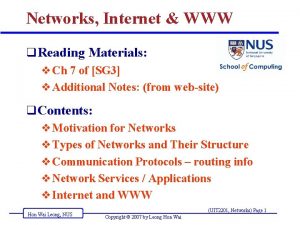CHAPTER 17 COMMUNICATION Lee Sai Leong Principles of






















- Slides: 22

CHAPTER 17 COMMUNICATION Lee Sai Leong Principles of Management | 1

Learning Outcomes 17. 1 Describe the importance and the role of communication in a manager’s job. 17. 2 Explain the basic forms of communication in organizations. 17. 3 Discuss informal communication and its different forms. 17. 4 Describe how to manage the communication process to correctly address various barriers to effective communication. Principles of Management | 2

Communication Defined • Communication is the process of transmitting information from one person to another. • Effective communication is the process of sending a message so that the message received is as close in meaning as possible to the intended message. Principles of Management | 3

Characteristics of Valuable Information 1. 2. 3. 4. Accurate - information is free from error Timely - information is received when it is needed Complete - information contains all the important facts Relevant - information is absolutely necessary for a decision maker Principles of Management | 4

The Communication Process Principles of Management | 5

Forms of Communication in Organizations • Interpersonal Communication (Oral or Written) • Oral communication is the spoken word that is used to convey meaning to listeners. • Putting it in the written word (black and white), in the form of a letter, email, memorandum, or report, is permanent. Principles of Management | 6

Choosing the Correct Form Depends on the situation • If the message is personal, non-routine or brief, oral communication, email or short messaging system (SMS) is preferred. • When the message is impersonal, routine and longer, written communication may be a better choice. Principles of Management | 7

Communication Structure in Groups and Teams 5 basic types of communication networks in an organization, which are the wheel, Y, chain, circle and all-channel structures. • wheel is a centralized network and is superior for handling simple tasks • Y structure is where there could be one or more persons connected indirectly to the center or leader, and it is very similar to the wheel structure Principles of Management | 8

Communication Structure in Groups and Teams • 5 basic types of communication networks in an organization, which are the wheel, Y, chain, circle and. all-channel structures (cont’d) • Chain, also known as line structure, is where communication is restricted to certain group members, even though all members are connected • The circle structure is similar to the chain structure, where two members are connected • The all-channel, a decentralized network, is superior for performing complex tasks Principles of Management | 9

Communication network structures Principles of Management | 10

Principles of Management | 11

Organizational Communication • Vertical communication flows up and down the organization, usually along formal reporting relationships • Upward communications are messages from subordinates to superiors • Downward communication takes place when information flows down the organization’s hierarchy from superiors to subordinates • Horizontal communication involves information flow between colleagues and peers at the same level of the organization Principles of Management | 12

Principles of Management | 13

Informal Communication in Organizations • The grapevine is an informal communication network among workers in an organization. • Gossip chain , a person spreads the message to many people. • In the cluster chain , a person communicates the information to only a few selected individuals. Principles of Management | 14

Principles of Management | 15

Management by Wandering Around (MBWA) • MBWA refers to a style of business management with managers moving around the workplace, in an unstructured manner, at any time, to keep in touch and talk with employees. • Bill Hewlett and David Packard, co-founders of Hewlett-Packard, institutionalized company-wide MBWA practices in their start-up company in the 1940 s. Principles of Management | 16

Management by Wandering Around (MBWA) (cont’d) • Practiced by many successful CEOs such as Mc. Donald’s founder Ray Kroc, automotive industry leader Lee Iacocca, and General Electric CEO Jack Welch. • Air. Asia CEO Tan Sri Tony Fernandes has told bosses to go down to the ground if they want to become good leaders. "You cannot know what's going on if you're only in the office, " he said at the 7 th Annual Malaysian Student Leaders Summit Sunday afternoon. Principles of Management | 17

Nonverbal Communication • There are eight traditional dimensions of nonverbal communication. • A manager needs to understand these dimensions and how they relate to his communication skills. • Physical appearance is the first nonverbal message received and can be used to develop judgments about people based on how they look. • Territory and Personal Space (Proxemics) • Personal space refers to the space an individual maintains around himself. • Facial Expressions • The most important nonverbal channel to express attitudes and emotions to others is the face (Argyle, 1988). Principles of Management | 18

Nonverbal Communication (cont’d) • Gestures and Postures • Gestures and postures are frequent and continuous movements of the body that reflect individual thought processes and regulate communication (Goldman, 1994). • Touch • The most basic meaning of touch is that an interpersonal bond is being offered or established (Argyle, 1998). • Eye Contact • Eye contact regulates conversation and signals the exchange of speaker and listener roles. Principles of Management | 19

Nonverbal Communication (cont’d) • Vocal Cues that Accompany Speech (Paralanguage) • Vocal cues such as intonation, voice quality and vocal emphasis can enhance verbal meaning. • Time (Chronemics) • The way an individual uses or talks about time can communicate much nonverbal information about him. Principles of Management | 20

Managing Organizational Communication • There are 10 barriers to organizational communication Principles of Management | 21

Other Blocks to Communication • Failure to listen. Communicator may not be able to speak freely to the listener if the listener is not listening carefully or not responding. • Conflicting verbal and non-verbal message. • Failure to interpret with knowledge. • Changing the subject. A quick way to stop communicating is to change the subject. • Inappropriate comments & questions. Certain comments &questions should be avoided in most situations because they tend to impede effective communication, e. g. , close-ended questions & using comments that give advice. Principles of Management | 22
 Tyler leong
Tyler leong Yoon tiem leong
Yoon tiem leong Goh bak leong
Goh bak leong Yoon tiem leong
Yoon tiem leong Christine leong
Christine leong Tay kwang leong
Tay kwang leong Milton leong
Milton leong Ben leong medium
Ben leong medium Ed leong
Ed leong Cs-1101
Cs-1101 Leong hon wai
Leong hon wai Chapter 11 section 3 motion and force answer key
Chapter 11 section 3 motion and force answer key Saiinfotech
Saiinfotech It is the combination of phipat and khruang-sai.
It is the combination of phipat and khruang-sai. Arishadvarga meaning
Arishadvarga meaning Cfs saigonnewport
Cfs saigonnewport Sai kung swimming pool
Sai kung swimming pool Matt carver sai
Matt carver sai Minda sai company
Minda sai company Ho sbagliato tante volte sai
Ho sbagliato tante volte sai Nú sai do ventre de minha mãe musica
Nú sai do ventre de minha mãe musica Derivasaun katak sa
Derivasaun katak sa Sai krishna kamepalli
Sai krishna kamepalli











































